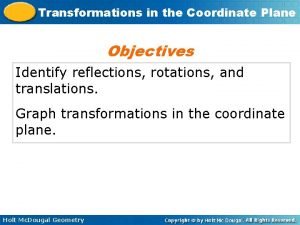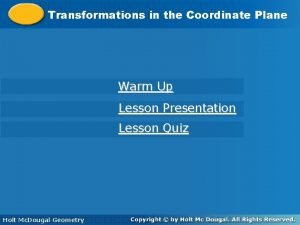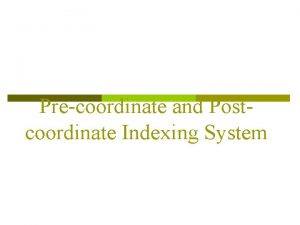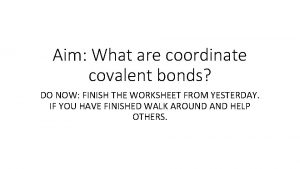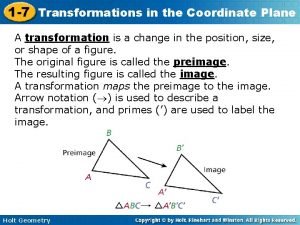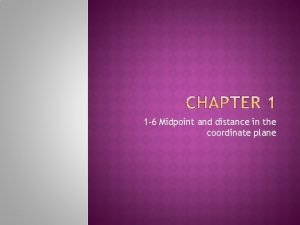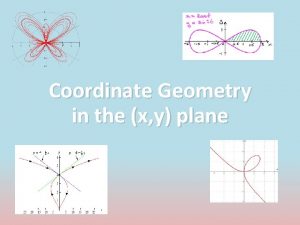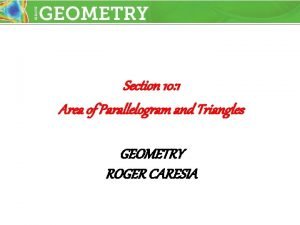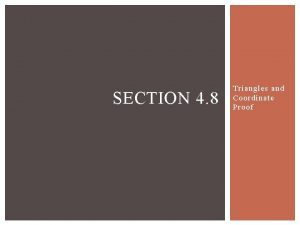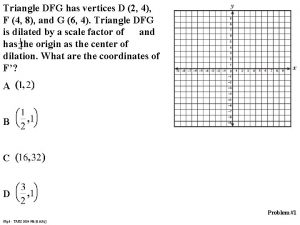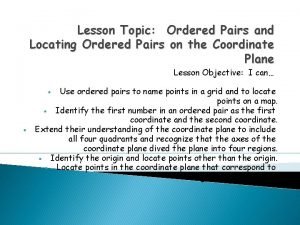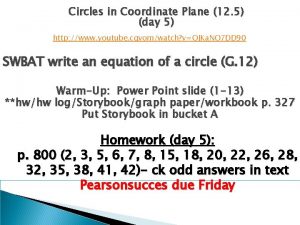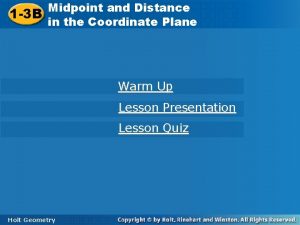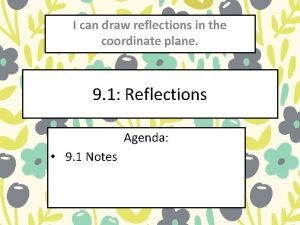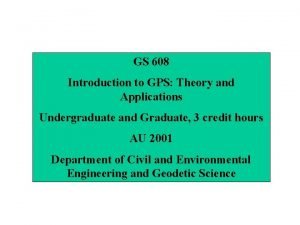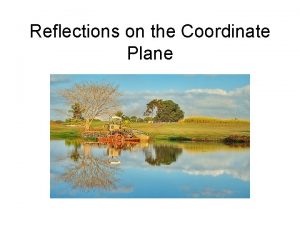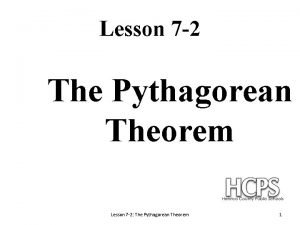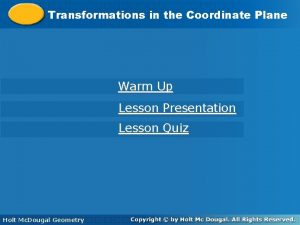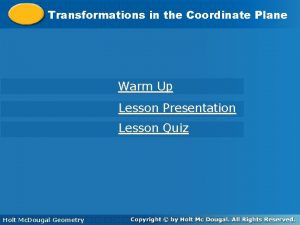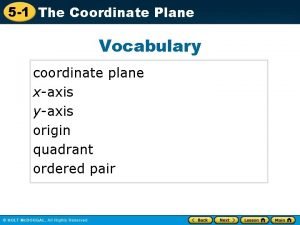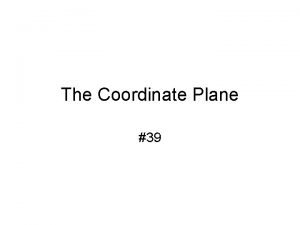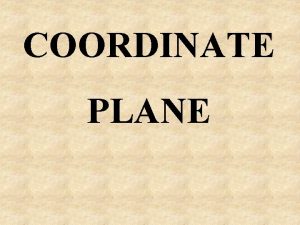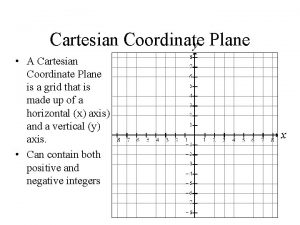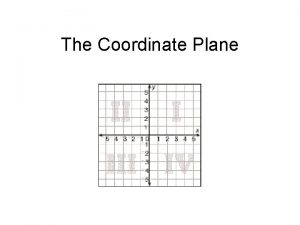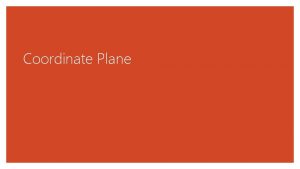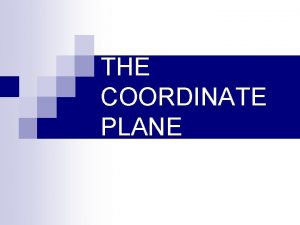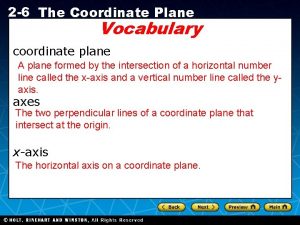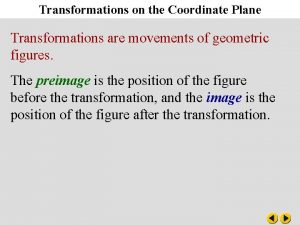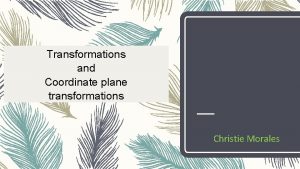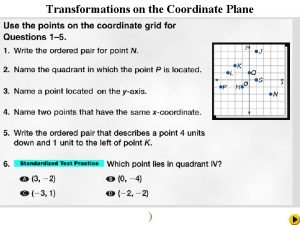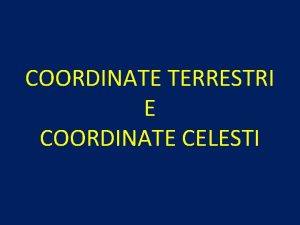1 7 Transformations in the Coordinate Plane A


















- Slides: 18

1 -7 Transformations in the Coordinate Plane A transformation is a change in the position, size, or shape of a figure. The original figure is called the preimage. The resulting figure is called the image. A transformation maps the preimage to the image. Arrow notation ( ) is used to describe a transformation, and primes (’) are used to label the image. Holt Geometry

1 -7 Transformations in the Coordinate Plane Holt Geometry

1 -7 Transformations in the Coordinate Plane An isometry is a transformation that does not change the shape or size of a figure. Reflections, translations, and rotations are all isometries. Isometries are also called congruence transformations or rigid motions. Holt Geometry

1 -7 Transformations in the Coordinate Plane Example 1 A: Identifying Transformation Identify the transformation. Then use arrow notation to describe the transformation. 90° rotation, ∆ABC ∆A’B’C’ Holt Geometry

1 -7 Transformations in the Coordinate Plane Example 1 B: Identifying Transformation Identify the transformation. Then use arrow notation to describe the transformation. reflection, DEFG D’E’F’G’ Holt Geometry

1 -7 Transformations in the Coordinate Plane Example 2 Identify each transformation. Then use arrow notation to describe the transformation. a. translation; MNOP M’N’O’P’ Holt Geometry b. rotation; ∆XYZ ∆X’Y’Z’

1 -7 Transformations in the Coordinate Plane Example 3: Identifying Transformations A figure has vertices at A(1, – 1), B(2, 3), and C(4, – 2). After a transformation, the image of the figure has vertices at A'(– 1, – 1), B'(– 2, 3), and C'(– 4, – 2). Identify the transformation. The transformation is a reflection across the y-axis because each point and its image are the same distance from the y-axis. Holt Geometry

1 -7 Transformations in the Coordinate Plane Holt Geometry

1 -7 Transformations in the Coordinate Plane Example 4 A figure has vertices at E(2, 0), F(2, -1), G(5, -1), and H(5, 0). After a transformation, the image of the figure has vertices at E’(0, 2), F’(1, 2), G’(1, 5), and H’(0, 5). Identify the transformation. The transformation is a 90° counterclockwise rotation. Holt Geometry

1 -7 Transformations in the Coordinate Plane Holt Geometry

1 -7 Transformations in the Coordinate Plane Translations can be described by a rule such as (x, y) (x + a, y + b). To find coordinates for the image of a figure in a translation, add a to the x-coordinates of the preimage and add b to the y-coordinates of the preimage. Holt Geometry

1 -7 Transformations in the Coordinate Plane Example 5: Translations in the Coordinate Plane Find the coordinates for the image of ∆ABC after the translation (x, y) (x + 2, y - 1). Step 1 The vertices of ∆ABC are A( – 4, 2), B(– 3, 4), C(– 1, 1). Holt Geometry

1 -7 Transformations in the Coordinate Plane Example 5 Continued Step 2 Apply the rule to find the vertices of the image. A’(– 4 + 2, 2 – 1) = A’(– 2, 1) B’(– 3 + 2, 4 – 1) = B’(– 1, 3) C’(– 1 + 2, 1 – 1) = C’(1, 0) Holt Geometry

1 -7 Transformations in the Coordinate Plane Example 6 Find the coordinates for the image of JKLM after the translation (x, y) (x – 2, y + 4). Draw the image. Step 1 The vertices of JKLM are J(1, 1), K(3, 1), L(3, – 4), M(1, – 4), . Holt Geometry

1 -7 Transformations in the Coordinate Plane Check It Out! Example 6 Continued Step 2 Apply the rule to find the vertices of the image. J’(1 – 2, 1 + 4) = J’(– 1, 5) J’ K’ K’(3 – 2, 1 + 4) = K’(1, 5) L’(3 – 2, – 4 + 4) = L’(1, 0) M’(1 – 2, – 4 + 4) = M’(– 1, 0) M’ Holt Geometry L’

1 -7 Transformations in the Coordinate Plane Example 7 Point A has coordinate (1, 6). Point A’ has coordinate (-2, 7). Write the translation rule. To translate A to A’, 3 units are subtracted from the x-coordinate and 1 unit is added to the y-coordinate. Therefore, the translation rule is (x, y) → (x – 3, y + 1). Holt Geometry

1 -7 Transformations in the Coordinate Plane Lesson Quiz: Part I 1. A figure has vertices at X(– 1, 1), Y(1, 4), and Z(2, 2). After a transformation, the image of the figure has vertices at X'(– 3, 2), Y'(– 1, 5), and Z'(0, 3). Identify the transformation. Translation – what is the translation rule? 2. What transformation is suggested by the wings of an airplane? reflection Holt Geometry

1 -7 Transformations in the Coordinate Plane Lesson Quiz: Part II 3. Given points P(-2, -1) and Q(-1, 3), draw PQ and its reflection across the y-axis. What are the coordinates of the reflection? 4. Find the coordinates of the image of F(2, 7) after the translation (x, y) (x + 5, y – 6). (7, 1) Holt Geometry
 Rotations on the coordinate plane
Rotations on the coordinate plane Transformations in the coordinate plane
Transformations in the coordinate plane Transformation in coordinate plane
Transformation in coordinate plane Software-defined networking: a comprehensive survey
Software-defined networking: a comprehensive survey Coordinate indexing
Coordinate indexing Coordinate covalent bond
Coordinate covalent bond 1-7 transformations in the plane
1-7 transformations in the plane Midpoint and distance in the coordinate plane worksheet
Midpoint and distance in the coordinate plane worksheet Coordinate geometry in the (x y) plane
Coordinate geometry in the (x y) plane Perimeter of a triangle on a coordinate plane
Perimeter of a triangle on a coordinate plane 4-8 triangles and coordinate proof
4-8 triangles and coordinate proof What is the area of triangle dfg
What is the area of triangle dfg Locating ordered pairs on the coordinate plane
Locating ordered pairs on the coordinate plane 12-5 practice circles in the coordinate plane
12-5 practice circles in the coordinate plane Distance formula steps
Distance formula steps Reflection on coordinate plane
Reflection on coordinate plane Ohio state plane coordinate system
Ohio state plane coordinate system Reflections in the coordinate plane
Reflections in the coordinate plane How to identify a right triangle
How to identify a right triangle

